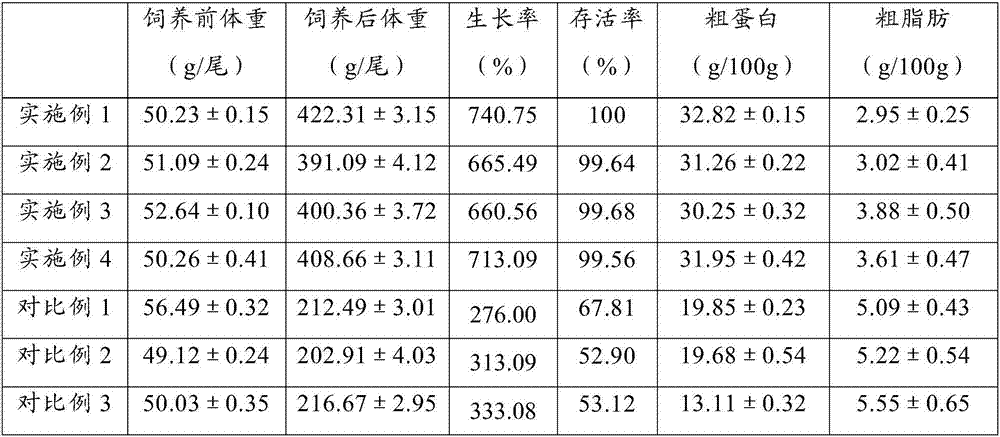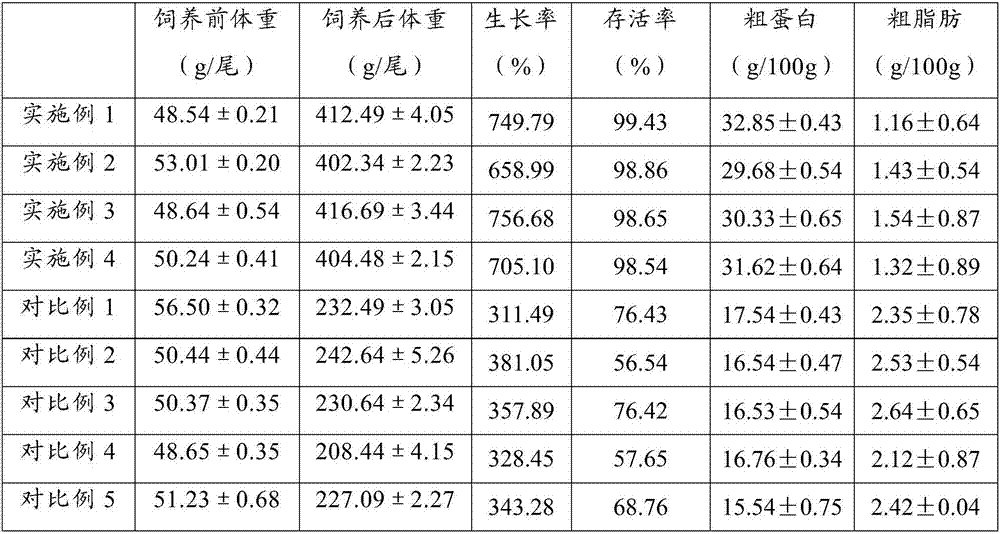Environment-friendly deep sea cage culture feed and preparation method thereof
A deep-sea cage, environmentally friendly technology, applied in animal feed, animal feed, climate change adaptation and other directions, can solve the problems of low fish food intake, slow growth rate of marine fish, water pollution, etc., and achieve body fat and abdominal fat. The effect of low content, no bad smell and high survival rate
- Summary
- Abstract
- Description
- Claims
- Application Information
AI Technical Summary
Problems solved by technology
Method used
Image
Examples
Example Embodiment
[0016] Example 1:
[0017] An environmentally friendly feed for deep-sea cage culture, including the following components: 10% soy protein powder, 4% quesadilla, 10% gluten, 5% copper sulfate, 11% peanut meal, 10% progesterone, and monens Vegetarian sodium 3.2%, red yeast 0.7%, citronellal 6%, sodium ferulate 0.5%, selenate polysaccharide 3%.
[0018] Preparation steps:
[0019] a. Crush the quesadilla powder, sieving through a 500-mesh sieve, and add peanut meal to obtain the peanut quesadilla powder;
[0020] b. Cultivate the prescription amount of red yeast in a medium containing copper sulfate and sodium ferulate, isolate the yeast, and dry it to obtain yeast powder;
[0021] c. Mix soy protein powder, progesterone, monensin sodium, and selenate polysaccharides evenly, crush them, pass a 300-mesh sieve, add the peanut meal pea powder of step a, mix well, sterilize, add grains The prion powder, citronellal and the yeast powder of step b are granulated and then obtained.
Example Embodiment
[0022] Example 2:
[0023] An environmentally-friendly deep-sea cage culture feed, including the following components by mass percentage: 13% soy protein powder, 7% quercetto, 10% gluten, 5% copper sulfate, 10% peanut meal, 12% progesterone, Monensin sodium 3.7%, red yeast 1.0%, citronellal 6%, sodium ferulate 0.7%, selenate polysaccharide 3%.
[0024] Preparation steps:
[0025] a. Crush the quesadilla powder, sieving through a 400-mesh sieve, and add peanut meal to obtain the peanut quesadilla powder;
[0026] b. Cultivate the prescription amount of red yeast in a medium containing copper sulfate and sodium ferulate, isolate the yeast, and dry it to obtain yeast powder;
[0027] c. Mix the soy protein powder, progesterone, monensin sodium, and selenate polysaccharides evenly, crush them, pass a 200-mesh sieve, add the peanut meal pea powder of step a, mix well, sterilize, and add grains The prion powder, citronellal and the yeast powder of step b are granulated and then obtained.
Example Embodiment
[0028] Example 3:
[0029] An environmentally friendly feed for deep-sea cage culture, comprising the following components by mass percentage: 8% soy protein powder, 3% quercetto, 12% gluten, 2% copper sulfate, 19% peanut meal, 7% progesterone, Monensin sodium 3%, red yeast 0.5%, citronellal 2%, sodium ferulate 0.3%, selenate polysaccharide 7%.
[0030] Preparation steps:
[0031] a. Crush the quesadilla powder, sieving through a 400-mesh sieve, and add peanut meal to obtain the peanut quesadilla powder;
[0032] b. Cultivate the prescription amount of red yeast in a medium containing copper sulfate and sodium ferulate, isolate the yeast, and dry it to obtain yeast powder;
[0033] c. Mix soy protein powder, progesterone, monensin sodium, and selenate polysaccharides evenly, crush them, pass a 300-mesh sieve, add the peanut meal pea powder of step a, mix well, sterilize, add grains The prion powder, citronellal and the yeast powder of step b are granulated and then obtained.
PUM
 Login to view more
Login to view more Abstract
Description
Claims
Application Information
 Login to view more
Login to view more - R&D Engineer
- R&D Manager
- IP Professional
- Industry Leading Data Capabilities
- Powerful AI technology
- Patent DNA Extraction
Browse by: Latest US Patents, China's latest patents, Technical Efficacy Thesaurus, Application Domain, Technology Topic.
© 2024 PatSnap. All rights reserved.Legal|Privacy policy|Modern Slavery Act Transparency Statement|Sitemap



